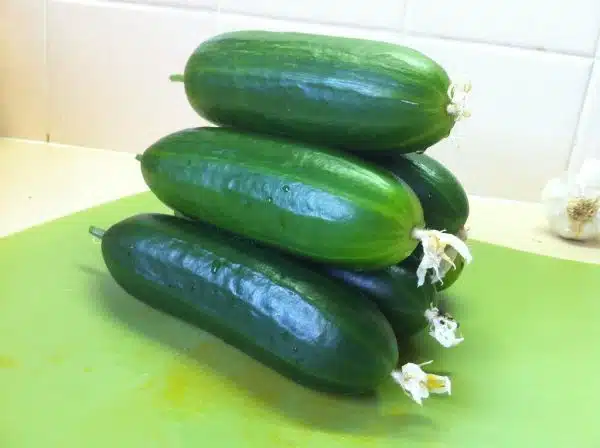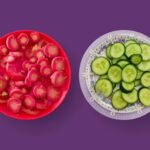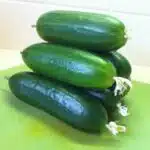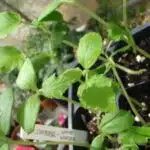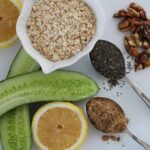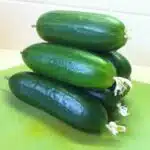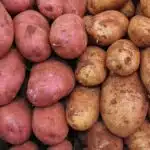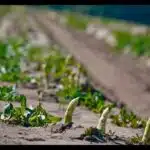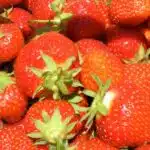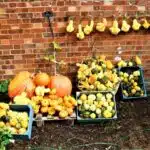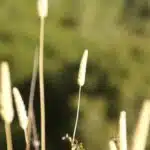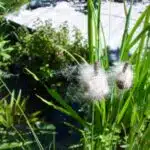Cucumbers are a popular and versatile vegetable that can be eaten raw, pickled or cooked. Harvesting cucumbers is an essential part of growing them, as the timing and method of harvest can greatly affect their flavor, texture, and overall quality. As an expert in cucumber harvesting, I will provide you with valuable information on how and when to harvest cucumbers to ensure that they are at their best when served to your family or guests.
Cucumbers are usually ready for harvest between 50-70 days after planting. The ideal time to harvest cucumbers is when they have reached mature size but are still firm and have a bright green color. Overripe cucumbers tend to be yellow in color and develop a bitter taste. Harvesting cucumbers regularly also helps the plant produce more fruit. In this article, I will discuss the different methods of harvesting cucumbers as well as tips on how to store them properly so that you can enjoy fresh, delicious cucumbers all season long.
The Best Time To Harvest Cucumbers
As a cucumber harvesting expert, I liken the process of harvesting cucumbers to that of selecting ripe fruits from a tree. Just as an apple or peach must be plucked at its optimal ripeness, so too must a cucumber be harvested at the right time. However, unlike fruits that typically have visual cues signaling their readiness for harvest, cucumbers require keen attention and knowledge of harvesting techniques.
Knowing when to harvest cucumbers is crucial to ensure that they reach optimal maturity without becoming overripe or underdeveloped. One of the key ripeness indicators is the size of the cucumber. Generally, cucumbers should be picked when they reach six to eight inches in length for slicing varieties and two to four inches for pickling varieties. Another important factor to consider is texture – mature cucumbers should feel firm and solid with no visible signs of softness or wrinkling.
While there are several other factors that determine when to harvest cucumbers including weather conditions and plant variety, mastering these basic guidelines will help ensure successful cucumber cultivation. In the subsequent section, we will delve deeper into signs of maturity in cucumbers, providing you with all the information you need to become an expert cucumber harvester.
Signs Of Maturity In Cucumbers
Identifying ripeness in cucumbers is essential for a successful harvest. While size is a factor, it’s not the only one to consider. The best way to tell if a cucumber is ready to be picked is by examining its skin. Mature cucumbers will have skin that’s firm, smooth and no longer glossy. You should also check the ends of the cucumber – they will turn yellowish when it’s ripe.
Checking color is another important sign of maturity in cucumbers. Green cucumbers are not always fully mature, so it’s good to look for other indications as well. Some varieties may have a different color or pattern when they’re ready to be harvested, but most cucumbers will have a consistent green color throughout their length. Be wary of any blemishes or discolorations on the skin as this may indicate an overripe or damaged cucumber.
It’s important to harvest your cucumbers at their peak ripeness because they won’t continue to ripen once they’ve been picked from the vine. Overripe cucumbers can also cause problems with future crops since dead vines can attract pests and disease. By following these tips for identifying ripeness and checking color, you’ll ensure that you’re harvesting your cucumbers at just the right time for optimal flavor and texture.
Transition into subsequent section: As an expert in cucumber harvesting, I know that choosing the right tools is crucial for ensuring a successful harvest.
Choosing The Right Tools For Harvesting Cucumbers
As a cucumber harvesting expert, choosing appropriate tools for the task is crucial. The right tools will not only make the process easier but will also ensure that you avoid damage to the plants. Think of it this way; just as a skilled surgeon selects the appropriate instruments for a successful procedure, so too must you select the right tools for harvesting cucumbers.
When selecting tools, keep in mind that cucumbers have delicate vines and leaves that can be easily damaged. Therefore, it’s important to choose tools that are gentle on the plant. Here are three items to consider adding to your harvesting tool kit:
- Pruning shears – these are perfect for snipping off mature cucumbers without damaging the vines or leaves.
- Soft gloves – these will protect your hands from scratches and blisters while also being gentle on the plant.
- Harvesting basket – this is an essential item to hold your harvested cucumbers without crushing or bruising them.
By choosing appropriate tools and handling them with care, you’ll ensure that your cucumber plants remain healthy and productive throughout their growing season.
As we move into discussing how to harvest cucumbers by hand, keep in mind that proper tool selection is only one piece of the puzzle when it comes to successful harvesting. In addition to selecting appropriate tools, timing is everything when it comes to picking cucumbers at their peak ripeness.
How To Harvest Cucumbers By Hand
Harvesting cucumbers by hand is a popular technique among gardeners and farmers. To ensure that you get the best possible yield, it’s important to use proper harvesting techniques. First, inspect the plant and look for mature cucumbers that are at least six inches long. You’ll want to remove them from the vine before they become overripe or yellow.
One common mistake people make when harvesting cucumbers is pulling them off the vine too forcefully. This can damage the vine or leave behind a portion of the cucumber, which can attract pests and disease. Instead, use a gentle twisting motion to detach the cucumber from the stem. If it doesn’t come off easily, it’s not ready yet.
Another mistake is waiting too long to harvest your cucumbers. Overripe cucumbers are bitter and have tough skins, making them unsuitable for eating or pickling. Harvesting frequently also encourages new growth and helps keep your plants healthy throughout the growing season. By following these tips, you’ll be well on your way to a bountiful cucumber harvest!
To take your harvesting skills to the next level, consider using scissors instead of your hands. This technique is especially useful for leafy vegetables like cucumbers because it minimizes damage to surrounding foliage and reduces the risk of introducing pathogens into open wounds on the plant. When using scissors to harvest cucumbers, hold them close to the stem and make a clean cut without squeezing too hard. This will help prevent damage to both the plant and surrounding fruits.
Using Scissors To Harvest Cucumbers
Using scissors to harvest cucumbers is a common practice among gardeners and farmers. One of the advantages of using scissors is that it provides a clean cut, leaving no damage to the plant. A sharp pair of scissors can easily cut through the stem, allowing you to harvest cucumbers without damaging the surrounding leaves and branches.
However, there are also disadvantages to using scissors for cucumber harvesting. One issue is that it can be time-consuming if you have a large number of plants. Additionally, if the scissors are not cleaned properly between plants, they can spread disease from one plant to another. It’s important to sanitize your tools regularly during harvesting to prevent disease transmission.
To avoid damaging the plant when using scissors for cucumber harvesting, it’s crucial to cut the stem close to the cucumber fruit but not too close as this may cause damage or bruising. The best way is to hold onto the cucumber with one hand while cutting with the other hand. This will ensure that you have control over both sides and avoid accidentally slicing through additional stems or leaves.
Next, we will discuss another tool commonly used for cucumber harvesting: pruning shears. With this tool, you can quickly harvest cucumbers without damaging the plant or fruit. By understanding how and when to use these tools effectively, you’ll be able to harvest your cucumbers efficiently and without any harm done to your plants.
Harvesting Cucumbers With Pruning Shears
To ensure that you harvest your cucumbers at the right time, it’s important to know when they’re ready. You can tell if a cucumber is ready for harvest by checking its size and color. A ripe cucumber should be green and firm, with a length of about six to eight inches.
When it’s time to harvest your cucumbers, using pruning shears is an effective method. Pruning shears allow you to cut the stem cleanly without damaging the plant or leaving a messy cut. It’s also easier to control the cutting depth with pruning shears compared to scissors, which can accidentally snip other parts of the plant.
The benefits of using pruning shears instead of scissors for harvesting cucumbers are numerous. By using pruning shears, you reduce the risk of damaging the plant or introducing diseases. Additionally, you’ll have more control over how deep you cut into the stem, ensuring that you only take what is necessary and leave behind healthy parts of the plant. With this method, you’ll be able to harvest your cucumbers efficiently and without any complications.
As an expert in cucumber harvesting techniques, I recommend using pruning shears when it comes time to collect your cucumbers from the plant. Not only does this method provide a clean cut that reduces damage and disease transmission, but it also allows for greater precision when harvesting. In our next section, we’ll discuss tips for harvesting cucumbers without damaging the plant further.
Tips For Harvesting Cucumbers Without Damaging The Plant
Preventing Damage
Cucumbers are delicate plants, and it is crucial to harvest them without causing any damage. Damaged cucumbers will have a shorter shelf life, and they may also attract pests and diseases, which can spread to healthy plants. To prevent damage, use sharp pruning shears or a knife to cut the stem cleanly about 1/4 inch above the cucumber. Do not pull or twist the cucumber off the vine as this can cause harm to both the plant and fruit.
Efficient Harvesting
When harvesting cucumbers, it is essential to do so efficiently to ensure that you get as many fruits as possible from your garden. One useful tip is to check your plants daily for ripe cucumbers. This will prevent overripe cucumbers from rotting on the vine and attracting pests. It is also best to harvest in the early morning when temperatures are cooler, and the cucumbers are less likely to wilt.
Harvesting Cucumbers for Pickling
If you plan on pickling your cucumbers, there are some additional considerations when harvesting them. For instance, you should aim for smaller-sized cucumbers that are no more than three inches long for optimal results. You should also avoid harvesting any cucumbers that have already begun to turn yellow or orange as these may not pickle well. Finally, be sure to pick your cucumbers before they become too mature; otherwise, they may develop a bitter taste.
Harvesting Cucumbers For Pickling
After reading about the potential harms of harvesting cucumbers, you might be tempted to give up on growing your own. But don’t despair! With a few tips and tricks, you can harvest cucumbers without damaging the plant.
When it comes to pickling cucumbers, timing is everything. The best time to harvest them is when they are between 2-6 inches long. If left on the vine too long, they will become bitter and less suitable for pickling. It’s also important to check your plants regularly as cucumbers can grow very quickly.
Once you’ve harvested your cucumbers, it’s time to start preserving them. One popular way of doing this is through pickling techniques. You’ll need vinegar, water, sugar, salt and any other spices or herbs you want to include in your recipe. Slice your cucumbers and pack them into jars with your desired spices before pouring the vinegar mixture over them. Seal the jars tightly and store in a cool dark place for several weeks before enjoying your homemade pickles!
As much as we love pickles, there’s nothing quite like biting into a fresh cucumber straight from the garden. In our next section, we’ll discuss how to properly harvest cucumbers for eating fresh without harming the plant.
Harvesting Cucumbers For Eating Fresh
Harvesting techniques for cucumbers depend on the variety and intended use. Generally, pickling cucumbers are harvested when they are small and firm, while slicing cucumbers are left on the vine to grow larger. When harvesting, look for cucumbers that have a bright green color and are firm to the touch. It is important to harvest frequently to encourage continuous production.
After harvesting, it is best to consume fresh cucumbers within a few days. Here are three reasons why eating fresh cucumbers is beneficial:
- Cucumbers are low in calories but high in nutrients such as vitamin K, vitamin C, magnesium, and potassium.
- The high water content in cucumbers helps with hydration and aids in digestion.
- The antioxidants in cucumbers may help reduce inflammation and improve overall health.
To maximize these benefits, consider growing a variety of cucumber types such as Persian or English cucumbers which tend to have thinner skins and seedless flesh.
Cucumber varieties can be selected based on personal preference for taste and texture. Some popular varieties include Armenian cucumber which has a mild flavor and thin skin, lemon cucumber which has a yellow color and sweet taste, or burpless cucumber which has less bitterness than other varieties. Regardless of the type of cucumber selected, proper harvesting techniques should be followed to ensure maximum freshness and nutritional value when eaten raw or used in recipes.
Transition: Now that you know how to harvest fresh cucumbers, let’s explore how to store them properly for maximum freshness.
How To Store Cucumbers For Maximum Freshness
Transition: Harvesting cucumbers is a rewarding experience, but it’s not the end of the journey. Once you have your fresh cucumbers in hand, it’s essential to preserve their flavor and texture for as long as possible. In this section, we’ll discuss cucumber storage hacks and preserving techniques that will help you savor the taste of your harvest.
Cucumbers are a unique vegetable that needs proper handling to make them last longer. The first step in preserving cucumbers is to store them at the right temperature and humidity. Cucumbers prefer cool temperatures between 50-55°F, and high humidity levels around 95%. When stored under these conditions, cucumbers can last up to two weeks.
Table:
| Storage Method | Temperature | Humidity | Shelf Life |
|---|---|---|---|
| Refrigerator | 50-55°F | 95% | Up to 2 weeks |
| Room Temperature (Short-Term) | 68-70°F | High humidity | Up to 1 week |
| Pickling | Varies | Varies | Indefinitely if sealed properly |
Aside from maintaining proper temperature and humidity, there are other cucumber storage hacks you can use to extend their shelf life. One strategy is to wrap them individually in paper towels before storing them in the fridge. This helps absorb excess moisture and prevent spoilage. Another technique is pickling cucumbers; this method involves immersing sliced or whole cucumbers in vinegar solution with added spices for preservation.
Preserving cucumbers is a crucial aspect of maximizing your harvest and enjoying its benefits all year round. By following the right storage methods and incorporating preservation techniques like pickling, you can keep your cucumbers fresh for extended periods without sacrificing their taste and texture. In the next section, we’ll explore the proper temperature and humidity for storing cucumbers, so you can keep yours fresh as long as possible.
Proper Temperature And Humidity For Storing Cucumbers
The optimal temperature for storing cucumbers is between 50 and 55 degrees Fahrenheit. High humidity levels of 90-95% are ideal for cucumbers to remain hydrated and maintain their firmness. Cucumbers should be harvested when the skin is firm and turgid, before the fruits become overly mature. The optimal time to harvest cucumbers is when they are 6-8 inches in length.
Proper Temperature
As a cucumber harvesting expert, it is important to understand the optimal temperature for harvesting cucumbers. Cucumbers are sensitive plants that require specific conditions to reach their full potential. The ideal temperature for harvesting cucumbers is between 60-70 degrees Fahrenheit. This temperature range ensures that the cucumbers are mature enough to be harvested and will also maintain their quality during storage.
Maintaining the optimal temperature during harvesting and storage is crucial to ensure that the cucumbers retain their freshness and flavor. If the temperature is too high, the cucumbers will ripen too quickly and become overripe, leading to a loss in quality. Alternatively, if the temperature is too low, the cucumbers will not ripen properly and will stay underdeveloped, which can affect their taste and texture.
It is essential to monitor the temperature closely during cucumber harvesting and storage. Temperature fluctuations can damage your crop, so it’s important to keep your cucumbers at a constant temperature throughout their growth cycle. By maintaining an optimal temperature range of 60-70 degrees Fahrenheit during cucumber harvesting and storage, you can ensure that your crop stays fresh and flavorful for longer periods without any loss in quality.
Humidity Levels
As a cucumber harvesting expert, I understand the importance of maintaining proper temperature and humidity levels to ensure the quality of cucumbers during storage. While temperature is crucial, the humidity levels must also be taken into account. High humidity can have a detrimental effect on cucumbers by causing moisture buildup, which can lead to mold growth and spoilage.
To maintain optimal humidity levels during cucumber storage, it is recommended to use dehumidifiers. These devices are designed to remove excess moisture from the air and maintain a consistent level of humidity in the storage area. By using dehumidifiers, you can prevent mold growth and keep your cucumbers fresh for longer periods.
The effect of high humidity on cucumbers cannot be overlooked. It is essential to monitor both temperature and humidity levels closely during cucumber storage to ensure that your crop stays fresh and flavorful. By keeping the temperature between 60-70 degrees Fahrenheit and using dehumidifiers to maintain optimal humidity levels, you can preserve the quality of your cucumbers for an extended period without any loss in quality or flavor.
How To Store Cut Cucumbers
After harvesting your cucumbers, you may want to slice them up for use in salads or as a snack. However, sliced cucumbers can quickly become wilted and unappetizing if not stored properly. Here are some tips for storing cut cucumbers:
- Keep them cold: Cut cucumbers should be stored in the refrigerator at a temperature between 32°F and 40°F. This will help slow down the process of decay and preserve their freshness.
- Use an airtight container: Place the sliced cucumbers in an airtight container to prevent moisture loss and exposure to air. This will also help maintain their crispness.
- Add some acid: Sprinkle some lemon juice or vinegar on top of the sliced cucumbers before storing, as the acid will act as a natural preservative.
By following these tips, you can extend the life of your sliced cucumbers and enjoy their fresh taste for longer periods of time.
Preserving cucumbers is another option for those who have harvested more than they can eat fresh. One way to do this is by pickling them. Pickling involves soaking sliced or whole cucumbers in a mixture of vinegar, salt, sugar, and spices. The acidic environment created by this mixture helps prevent bacteria growth and preserves the cucumber’s texture and taste.
Another method of preserving cucumbers is by freezing them. Sliced or diced cucumbers can be frozen without blanching, but it’s important to note that they may lose some of their crispness when thawed. Frozen cucumber slices are best used in recipes that call for cooked rather than raw vegetables.
As you can see, there are several ways to store and preserve your cucumber harvest beyond just eating them fresh. Whether you choose to slice and refrigerate or pickle and freeze, there are options available that will allow you to enjoy your homegrown cucumbers long after they’ve been harvested.
Moving on to the next topic, let’s discuss how long cucumbers can be stored using various preservation methods.
Length Of Time Cucumbers Can Be Stored
A cucumber, like any other fruit or vegetable, has a shelf life. It has a limited amount of time it can be stored before it loses its quality and freshness. The length of time cucumbers can be stored varies depending on several factors such as the maturity level at harvest, the storage temperature, and the method of preservation.
One way to store cucumbers is by keeping them in the refrigerator. In general, cucumbers can last for up to one week when stored in the fridge. However, this may vary depending on how mature they were when harvested. If they were picked too early or too late, they may not last as long. To maximize their shelf life, it’s best to store them in a plastic bag or container with a damp towel to help maintain their moisture.
Another way to preserve cucumbers is by pickling them. Pickled cucumbers have an extended shelf life compared to fresh ones and can last for up to six months if stored properly in a cool and dark place. The pickling process involves soaking sliced cucumbers in vinegar, salt, sugar, and spices for several hours or overnight. This method not only preserves the cucumber but also adds flavor and texture.
Transition: Now that you know how long cucumbers can be stored and preserved let’s explore another method of preserving them – freezing!
How To Freeze Cucumbers For Later Use
When choosing cucumbers for freezing, it is important to select cucumbers that are fully ripe and free of blemishes. For optimal results, cucumbers should be harvested in the morning to capture the highest concentration of flavor and nutrients. Before freezing, cucumbers should be washed, peeled, and cut into slices or cubes. Freezing cucumbers is an ideal way to preserve the summer harvest for later use.
Choosing Cucumbers For Freezing
Harvesting cucumbers at the right time is crucial to ensure that they are of optimal quality for freezing. When it comes to selecting cucumbers for freezing, it is important to choose the right variety. Not all cucumber varieties are suitable for freezing, and some may not maintain their texture and flavor after being frozen.
For best results when freezing cucumbers, choose pickling or slicing varieties that are firm and have thin skins. These types of cucumbers retain their crispness even after being frozen. Avoid using overripe or soft cucumbers as they tend to become mushy after freezing. Additionally, make sure to wash and dry the cucumbers thoroughly before slicing or dicing them for freezing.
There are various techniques for freezing cucumbers, including flash-freezing and blanching. Flash-freezing involves spreading sliced or diced cucumbers on a baking sheet and placing them in the freezer until they are completely frozen. Once frozen, transfer them into a freezer bag or airtight container. Blanching involves boiling sliced or diced cucumbers for a few minutes before plunging them into an ice bath to stop the cooking process. This method helps preserve their texture and color but may result in slightly softer cucumbers compared to flash-freezing. With these tips in mind, you can easily freeze your favorite cucumber varieties for later use without worrying about losing their texture or flavor.
Preparing Cucumbers For Freezing
To ensure that cucumbers are of optimal quality for freezing, it is crucial to prepare them properly. One technique for preparing cucumbers for freezing is blanching. Blanching involves boiling sliced or diced cucumbers for a few minutes before plunging them into an ice bath to stop the cooking process. This method helps preserve their texture and color, making them ideal for later use.
When choosing cucumbers for freezing, it is important to select pickling or slicing varieties that are firm and have thin skins. These types of cucumbers retain their crispness even after being frozen, ensuring that they maintain their quality and flavor when thawed. Before slicing or dicing the cucumbers, make sure to wash and dry them thoroughly.
After preparing the cucumbers, you can freeze them using various techniques such as flash-freezing or blanching. If you opt for blanching, make sure to follow the proper procedure to prevent overcooking and ensure that the cucumbers maintain their texture and color. Pickling cucumbers before freezing can also help preserve their flavor and texture. With these tips in mind, you can easily freeze your favorite cucumber varieties for later use without worrying about losing their quality or taste.
Troubleshooting Common Problems With Cucumber Harvesting
Common problems with cucumber harvesting can be frustrating for growers who have put in the time and effort to cultivate their crop. One of the most common mistakes is waiting too long to harvest cucumbers. While it may be tempting to wait until the fruit is larger, this can actually result in a decrease in yield as overripe cucumbers will start to rot on the vine. To prevent waste, it is important to harvest cucumbers when they are firm and just starting to turn color.
Another issue that can arise during cucumber harvesting is damage caused by improper handling. When picking cucumbers, it is important to avoid pulling or twisting the fruit from the vine, as this can cause damage and reduce yield. Instead, use a sharp knife or pruning shears to cut the stem close to the base of the cucumber. Additionally, be careful not to stack harvested cucumbers on top of each other as this can cause bruising and lead to spoilage.
Maximizing yield during cucumber harvesting involves taking steps early on in the growing process. Providing adequate water and nutrients throughout the growing season will help ensure healthy plants that produce abundant fruit. Additionally, regular pruning of excess foliage will promote air flow through the plant and prevent disease. By following these guidelines for proper cucumber harvesting techniques, growers can expect a bountiful harvest while minimizing waste and avoiding damage.
Conclusion
Cucumber harvesting is an important step in ensuring the best quality and yield from your garden. Knowing when to harvest cucumbers is crucial to their flavor, texture, and longevity. Signs of maturity include firmness, size, and color. When harvesting cucumbers by hand or with scissors, it’s important to avoid damaging the plant or leaving behind any pieces on the vine.
Proper storage of cut cucumbers can extend their shelf life for up to a week in the refrigerator. Freezing is also an option for preserving cucumbers for later use in smoothies or salads. Common problems with cucumber harvesting include overripeness, underripeness, and damage from pests or weather.
In one case study, a gardener noticed that their cucumbers were turning yellow too quickly after being harvested. Upon inspection, it was discovered that they were not being picked at the proper maturity level. After adjusting their harvesting technique and timing, the gardener was able to enjoy perfectly ripe cucumbers for weeks on end. Remembering these tips and tricks will ensure a successful cucumber harvest every time.
Image Credits
- “Cucumber Harvest” by David Davies (featured)

